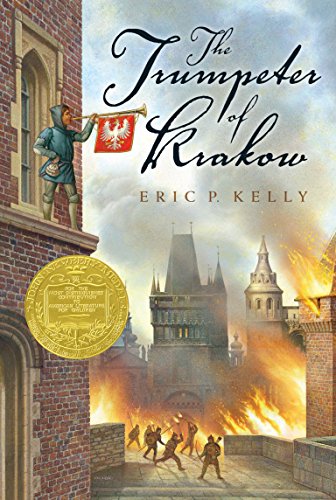On this page: General Resources | Plague | Eleanor of Aquitaine | Joan of Arc | Cathedrals | Manuscript Illumination | Historical Fiction
general resources
📖 Medieval World Series from Crabtree Publishing. Each of the many entries in this series explores a single aspect of Medieval European life, such as religion, medicine, science, and food. These information-packed non-fiction books can nicely supplement an upper Elementary or Middle School study of the Middle Ages. – Elementary • Middle
📖 The Measly Middle Ages and other Horrible History books by Terry Deary. “Discover all the foul facts about the Measly Middle Ages—all the gore and more!” Here is an entertaining addition to your study of the Middle Ages, full of gross but fascinating information. The focus is on the history of England. Also look for Smashing Saxons and Stormin' Normans. – Elementary • Middle
▶️ Horrible Histories TV show. Episodes of the popular “Horrible Histories” sketch show are available to stream on Amazon Prime, Hulu, and YouTube. Search our Horrible Histories Sketch List to find every “Smashing Saxons” and “Measly Middle Ages” sketch from Seasons 1–5. – Elementary • Middle
📖 The European World, 400–1450 by Barbara Hanawalt. This Oxford University Press title is recommended as a spine for a middle grade study of Medieval Europe. In 12 chapters, Hanawalt takes readers from the Fall of Rome through the spread of Christianity, Norman conquest, Medieval culture, plague, war, and more to the dawn of the Renaissance world. – Middle
🖐️ Days of Knights and Damsels: An Activity Guide by Laurie Carlson. For families who enjoy arts & crafts, here is a fun activity book with project ideas to round out a study of the European Middle Ages. Try creating a Medieval outfit and coat of arms, making bread and butter, dipping candles, playing games, and more. – Elementary
🔗 Content Connection: Africa & Middle East. Learn all about the Crusades.
🔗 Content Connection: Knights & Castles. No study of Medieval Europe is complete without a unit on knights.
🔗 Content Connection: Medieval Literature. Enrich your study with stories of King Arthur, Robin Hood, and others.
▶️ The Dark Ages from Crash Course. “John Green teaches you about the so-called Dark Ages, which it turns out weren't as uniformly dark as you may have been led to believe. While Europe was indeed having some issues, many other parts of the world were thriving and relatively enlightened. John covers European Feudalism, the cultural blossoming of the Islamic world, and the scientific and artistic advances in China, all during these ‘Dark Ages.’” – All
plague
📖 The Black Death by Diane Zahler. This title in the "Pivotal Moments in History" series examines the causes and consequences of the 14th century plague epidemic in some detail. Read about how living conditions in Medieval Europe set the stage for the spread of the plague, about the bacterium that causes the disease, and about Europe's response to the devastation of the Black Death. – Middle • High
🔗 Content Connection: Microbes & Disease. Study bacteria and infectious diseases.
▶️ The past, present and future of the bubonic plague from TED-Ed."The bubonic plague, which killed around 1/5 of the world’s population in the 14th century, is still around today—but it now claims only a few thousand lives each year. How did that number shrink so drastically?" – All
Eleanor of Aquitaine
📖 Queen Eleanor: Independent Spirit of the Medieval World by Polly Schoyer Brooks. Meet the remarkable Eleanor of Aquitaine, the woman who would become Queen of France and then of England, in this engagingly written chapter book biography: "Once described by a contemporary as 'a woman beyond compare,' Eleanor of Aquitaine is a figure who will remain controversial, powerful, and enchanting in the twenty-first century." – Middle • High
📖 A Proud Taste for Scarlet and Miniver by E. L. Konigsberg. This beloved National Book Award finalist begins with an unusual premise: "Eleanor of Aquitaine, wife to two kings, mother to two others, has been waiting in Heaven a long time—eight centuries, more or less—to be reunited with her second husband, Henry II of England. Finally, the day has come when Henry will be judged for admission. While Eleanor, never a patient woman in life or afterlife, waits, three people, each of whom was close to Eleanor during a time of her life, join her." – Middle
joan of arc
📖 Joan of Arc by Diane Stanley. This short, heavily illustrated biography of Joan of Arc is a must-read resource for a study of the Hundred Years’ War. Stanley does a great job of putting Joan of Arc's unusual life story into historical context. Highly recommended. – Elementary • Middle
cathedrals
📖 Cathedral by David Macaulay. Here's the go-to resource for students who are curious to learn how the towering Gothic cathedrals of the Middle Ages were built. With his trademark detailed illustrations and informative text, Macaulay guides readers through the construction of a fictional cathedral in Medieval France. Highly recommended. – Elementary • Middle
📖 You Wouldn’t Want to Work on a Medieval Cathedral!: A Difficult Job that Never Ends by Fiona Macdonald and David Antram. It was no fun to actually be a laborer on a Medieval cathedral, as this entertaining book in the You Wouldn’t Want to … series clearly explains. – Elementary • Middle
manuscript illumination
📖 Marguerite Makes a Book by Bruce Robertson. Set in Paris during the late Middle Ages, this is a wonderful introduction to the art of manuscript illumination. Marguerite must help her father complete a Book of Hours for his patron. Over the course of the day, we follow her as she collects materials from merchants across the city, then returns to the studio, mixes the paints, and illuminates the book. Charming illustrations. – Elementary • Middle
📖 Magic in the Margins: A Medieval Tale of Bookmaking by W. Nikola-Lisa. This story of Simon, a young apprentice in a monastery scriptorium, celebrates the creativity and artistry of the Medieval manuscript illuminators. – Elementary
📖 The Ink Garden of Brother Theophane by C. M. Millen. Written in poetic verse, this gentle picture book tells the story of young Theophane, a monk in Medieval Ireland who creates a monastery ink garden. Nicely illustrated. The Author’s Note at the end gives some historical context and directs readers to a few websites to learn more about illumination and natural inks. – Elementary
historical fiction
📖 Brother William’s Year: A Monk at Westminster Abbey by Jan Pancheri. In this lovely little picture book, the fictional Brother William describes his day-to-day life as a monk and gardener at Westminster Abbey during the Middle Ages. – Preschool • Elementary
📖 The Hawk of the Castle: A Story of Medieval Falconry by Danna Smith. A girl and her father—the castle falconer—take a goshawk for a training flight in this lyrical picture book. The Author’s Note gives further information about the history of falconry. – Elementary
📖 Good Masters! Sweet Ladies! Voice from a Medieval Village by Laura Amy Schlitz. This Newbery winner consists of monologues and dialogs to be performed by children. The setting is a Medieval manor in England in the year 1255, and the characters are children from all walks of life, from the lord’s daughter to the tanner’s apprentice. Side notes and historical details accompany the pieces. An excellent and unusual addition to your study of the Middle Ages. – Middle
📖 The Minstrel in the Tower by Gloria Skurzynski. Turn to this Stepping Stones chapter book if you’re looking for an independent read for your Elementary School student: “Before their father returns to France from the Crusades, daring Alice and musical Roger set off on their own journey: to find their long-lost uncle. But on the way, the siblings are kidnapped and locked in an ancient hidden tower.” –Elementary
📖 Adam of the Road by Elizabeth Janet Gray. Written in 1942, this gentle Newbery Award winning novel is a classic: "Eleven-year-old Adam loved to travel throughout thirteenth century England with his father, a wandering minstrel, and his dog, Nick. But when Nick is stolen and his father disappears, Adam suddenly finds himself alone." – Elementary • Middle
📖 Otto of the Silver Hand by Howard Pyle. This classic novel, written and illustrated by Howard Pyle in 1888, is set in 13th century Germany. Note that the narrative reflects Pyle’s contemporary understanding of Medieval Europe: "Young Otto, born into a warring household in an age when lawless chiefs were constantly fighting each other or despoiling the caravans of the merchant burghers, is raised in a monastery only to return to his family's domain and become painfully involved in the blood feud between his father and the rival house of Trutz-Drachen." – Elementary • Middle
📖 Crispin: The Cross of Lead by Avi. This Newbery Medal winner is the first book in Avi’s acclaimed Crispin trilogy. "Accused of a crime he did not commit, he has been declared a ‘wolf’s head.’ That means he may be killed on sight, by anyone. If he wishes to remain alive, he must flee his tiny village. All the boy takes with him is a newly revealed name—Crispin—and his mother’s cross of lead." Also see Crispin at the Edge of the World and Crispin: The End of Time. – Elementary • Middle
📖 The Door in the Wall by Marguerite de Angeli. Here’s another classic Newbery Medal book set in Medieval Europe. Originally written in 1942, the story incorporates lots of Christian themes. Set in 14th century England, The Door in the Wall tells the story of Robin, the spoiled son of a noble family who must learn to adapt when an illness leaves him without the use of his legs. – Middle
📖 Catherine, Called Birdy by Karen Cushman. Cushman’s 1994 Newbery Honor Book is an entertaining tale, set in Medieval England: “Catherine, a spirited and inquisitive young woman of good family, narrates in diary form the story of her fourteenth year—the year 1290." – Middle
📖 The Midwife’s Apprentice by Karen Cushman. This Newbery Medal book is another modern classic from Cushman and a great literature link to include in a study of Medieval Europe: “The girl known only as Brat has no family, no home, and no future until she meets Jane the Midwife and becomes her apprentice. As she helps the sharp-tempered Jane deliver babies, Brat—who renames herself Alyce—gains knowledge, confidence, and the courage to want something from life.” – Middle
📖 Son of Charlemagne by Barbara Willard. Here’s a literature link to enrich a study of Charlemagne, during the Early Middle Ages: “The year is A.D. 781. King Charles of the Franks is crossing the Alps with his family and court on a journey to meet with Pope Hadrian. One frosty night he speaks to his young son Carl: When we come to Rome you will know that I am naming you my heir . . . But the King already had an heir, Pepin the Hunchback, mockingly called Gobbo." – Middle
📖 The Book of Boy by Catherine Gilbert Murdock. Murdock’s highly acclaimed 2018 novel, The Book of Boy, tells the story of the unusual Boy—who talks to animals and has a mysterious past—and his travels across Europe with the relic-hunter, Secondus, as they seek the relics of Saint Peter. –Middle
📖 The Trumpeter of Krakow by Eric P. Kelly. Published in 1928, Kelly’s Trumpeter of Krakow received the Newbery Medal: “There was something about the Great Tarnov Crystal . . . wise men spoke of it in hushed tones. Others were ready to kill for it. Now a murderous Tartar chief is bent on possessing it. But young Joseph Charnetski was bound by an ancient oath to protect the jewel at all costs.” – Middle
































